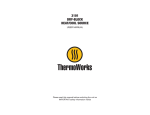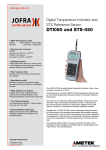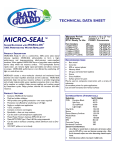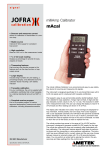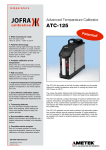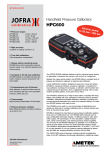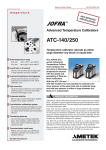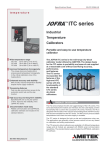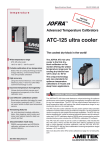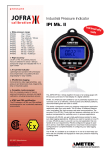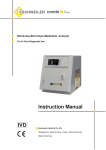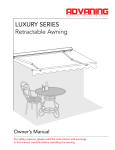Download Calibration of sanitary- and short temperature sensors in dry
Transcript
accessory Calibration of sanitary- and short temperature sensors in dry-blocks » Save time Fast temperature calibration using a dryblock calibrator » High accuracy Special reference sensor minimizes the measuring uncertainty » Improved repeatability Specially designed inserts ensure optimal heat-transfer around the sensor-under- test » Be prepared Tailor-made solution for sanitary and short sensors » Reduce setup errors Built-in measurement input for sensor-undertest and the reference sensor » Avoid defective cables Sensors are supplied with short, teflon protected cables to prevent damage during calibration » Documentation made easy USB communication and JOFRACAL calibration software are included in the standard delivery AMETEK offers a complete, highly accurate, and portable calibrationsolution. The kit is designed around a RTC-156 dry-block calibrator which features the intelligent dual-zone technology. Customized inserts and a reference sensor have been developed specifically for this application. Avoid cumbersome and lengthy liquid bath calibrations and the performance issues associated with older dry-block calibrators. The JOFRA RTC-156 employs dual-zone technology to maintain full control of the temperature in the lower part as well as in the upper part of the heating block. This enables the RTC-156 to compensate for the extreme heat dissipation through the flange of the sanitary sensor. A special insert with a large mechanical contact face at the top ensures optimal contact with the sanitary sensor. A small custom reference sensor is positioned in parallel with the sanitary sensor. The reference sensor accurately measures the insert temperature adjacent to itself and the sanitary sensor. The result is an accurate, fast, and easy calibration of sanitary temperature sensors. ISO 9001 Manufacturer Accessory Sheet, AS-Sanitary Sensors SANITARY CLAMP SENSORS Sanitary clamp sensors Most of the temperature sensors used for measurement within the food industry have to be approved for sanitary applications. Therefore, the temperature sensors have been designed in such a way that only a minimal number of germs or contaminants can conceal themselves on the sensors. Unfortunately, a side effect of these designs is a reduced ability for accurate measurement. The following illustration shows the fundamental construction of a dry-block calibrator, including: the metal block, insert fitted to the sensor-under-test, heating element and an internal reference sensor. To the left of the illustration, a graph shows the temperature through the block (axial gradient) at minimal load B1 and at a random load B2. It is obvious from these curves that a large thermal load like a sanitary clamp sensor cannot be calibrated using an ordinary dry-block calibrator. Sensor-under-test Often, the sensors are not very long and the process connection consists of a large metal flange. This allows for considerable heat dissipation through the sensor and process connection. As a result, the sensing element at the end of the sensor will rarely reach the same temperature as the process and will consequently provide an incorrect indication. B1 without load B2 with load Temperature Ideal temperature without energy loss The temperature gradient, and consequently the uncertainty in the calibration process becomes unmanageable. A similar gradient also applies to other short sensors that do not reach the bottom of the calibration block. New technology compensates... T2 Length The figure above graphically illustrates a temperature measurement through an isolating wall. The sensor is a Pt100 element with a specific extension meaning that the sensor will measure an average of its own temperature and the process temperature. It is obvious that there is a temperature gradient along the entire length of the sensor; this is indicative of the energy loss to ambient conditions. Due to the design compromises necessary for sanitary sensors, the apparent error due to this energy loss should be taken very seriously. Within the process there is typically a constant flow of liquid surrounding the sensor, this equalizes the temperature around the sensor and the temperature dissipation will be minimal. However; when connected for calibrations or other static applications, for example tank measurements, the effects of temperature dissipation may be quite significant. Incorrect temperature calibration The JOFRA RTC series of dry-block calibrators have a unique dual-zone heat control system. The design incorporates independent energy sources at the top and bottom of the block. The energy sources are controlled in such a way that temperature is kept uniform throughout the block despite thermal load. The upper zone is therefore able to compensate for the heat dissipation error. Sensor-under-test Upper zone Temperature T1 T2 Difference temperature Without load Main zone T1 "Set" temperature With load Internal reference Temperature The illustration above shows the dual-zone design. The graph indicates how the temperature is kept uniform despite the load. The previous section clearly explains that most sanitary sensors are a compromise between correct temperature measurement and hygienic considerations: an energy loss error is the price for the compromise. Temperature dissipation is also a consideration during calibration. This energy loss and the associated measurement error is so considerable that a dry-block calibrator designed without dual zone technology cannot be used. 2 www.jofra.com Sanitary Sensors • Accessory Sheet JOFRA RTC-156 & SANITARY KIT JOFRA RTC dual-zone heat source The JOFRA RTC-156 is a cooling calibrator covering the temperature range from -30 to + 155°C (-22 to 311°F). The heating/cooling block employs the JOFRA dual-zone design. This means that the unit compensates for the thermal gradient that arises as a function of the thermal load of the block during calibration. In other words, the calibrator senses and controls for heat dissipation. The JOFRA RTC series contains a number of other functions that make the calibration tasks easier, faster and more accurate. Below you see the custom insert and STS-102 A reference sensor placed in a JOFRA RTC-156 B dry-block calibrator. On the right, the sanitary sensor has been fitted into the insert and is ready for calibration. Note that the design makes room for the reference sensor cable. Custom insert To make sure that the sanitary sensor receives the necessary energy, we have developed a custom insert. The insert has a large flange corresponding to the flange of the sanitary sensors. When the two surfaces are in physical contact with each other, the error due to heat dissipation is minimized. Additionally, the setup is very similar to the process conditions in which the sensor is normally working. The insert on the right is complete while the insert on the left does not yet have the hole for the sanitary sensor. SET Follows TRUE All JOFRA RTC B and C models feature the unique SETfollows-TRUE function. The calibrators employ this function to adjust the temperature automatically, based on the correlation between the reference sensor and the desired calibration set-point. The end result is that any axial variations in temperature are recognized by the reference probe and the temperature is adjusted accordingly without the need for operator action. In this way, the risk of error is minimized, and no compensating calculations are necessary. Additionally, the operator is assured that calibrations always take place at fixed temperatures. Calibration software The JOFRA RTC series is also delivered with JOFRACAL calibration software for PC, offering further timesaving benefits. Create and perform all calibrations using this software and generate all of the necessary documentation for your calibrations. You may store calibration routines and calibration results in the calibrator itself, so it is not necessary to bring a PC into the process environment. Accuracy External reference sensor - calibration accuracy Optimal accuracy is achieved through the use of an external reference sensor during calibration. The reference sensor measures the temperature in the insert. The reference sensor must be placed at the same level and in parallel with the sensor that is to be tested as indicated in the illustration to the right. The illustration also very clearly shows that the flange of the sanitary sensor is in contact with the insert. We have also designed a special cable type reference sensor. Due to the small size and flexible connection, the design allows for positioning of the sensor under a sanitary flange. Accessory Sheet • Sanitary Sensors The JOFRA RTC series has been thoroughly tested in the AMETEK Denmark calibration laboratory with numerous sanitary and short temperature sensors. These sensors represent a large protion of the sensors that are used within the industry today. Results show that the proper insert and correct system application, you may acheive overall measuring uncertainties of 0.1 to 0.3°C including the reference sensor. Unfortunately, we have found that a few sensors, due to their construction, casue so big a heat loss that not even a JOFRA RTC-156 dual-zone calibrator is able to compensate for this. These sensores can only be calibrated with a considerably higher measuring uncertainty. www.jofra.com 3 Complete calibration kit for calibration of sanitary and short sensors STANDARD DELIVERY, 127279 • JOFRA STS-102 A sensor • 5 undrilled inserts • Accredited calibration certificate, 6 points from -45 to 155°C • Cable • User manual • Calibration tube • All above delivered in a plastic case AMETEK Test & Calibration Instruments A business unit of AMETEK Measurement & Calibration Technologies Division offering the following industry leading brands for test and calibration instrumentation. 127279 The complete application kit for calibration of sanitary temperature sensors with »clamp«. ACCESSORIES STS102A030EH 123824 123868 Reference sensor 5 Pack Undrilled Flange Sensors Inserts Special - Flange Insert * Drilled according to customer supplied drawing JOFRA Calibration Instruments Temperature Calibrators Portable dry-block calibrators, precision thermometers and liquid baths. Temperature ranges from -90°C(-130°F) to 1205°C(2200°F). Temperature sensors for industrial and marine use. Pressure Calibrators Convenient electronic systems ranging from -25 mbar to 1000 bar - fully temperature-compensated for problemfree and accurate field use. Signal Instruments Process signal measurement and simulation for easy control loop calibration and measurement tasks. M&G Pressure Testers & Pumps Pneumatic floating-ball or hydraulic piston dead weight testers with accuracies to 0.015% of reading. Pressure generators delivering up to 1,000 bar. Lloyd Instruments Materials testing machines and software from Lloyd Instruments guarantees expert materials testing solutions. The comprehensive program also covers Texture Analysers to perform rapid, general food testing and detailed texture analysis on a diverse range of foods and cosmetics. Davenport Polymer Test Equipment Allows measurement and characterization of moisturesensitive PET polymers and polymer density. Chatillon Force Measurement The hand held force gauges and motorized testers have earned their reputation for quality, reliability and accuracy and they represent the de facto standard for force measurement. Newage Testing Instruments Hardness testers, durometers, optical systems and software for data acquisition and analysis. STS102A030EH An STS-102A030 reference sensor in the small transportation and storage case. www.jofra.com UK AMETEK Calibration Instruments Tel +44 (0)1243 833 302 [email protected] France Denmark Singapore USA China AMETEK Denmark Tel +45 4816 8000 [email protected] AMETEK S.A.S. Tel +33 (0)1 30 68 89 40 [email protected] AMETEK Mansfield & Green Tel +1 (800) 527 9999 [email protected] Germany India AMETEK GmbH Tel +49 (0)2159 9136 510 [email protected] AMETEK Instruments India Pvt Ltd. Tel +91 22 2836 4750 [email protected] AMETEK Singapore Pte Ltd Tel +65 6484 2388 [email protected] AMETEK Inc. - Shanghai Tel +86 21 5868 5111 AMETEK Inc. - Beijing Tel +86 10 8526 2111 AMETEK Inc. - Guangzhou Tel +86 20 8363 4768 [email protected] Information in this document is subject to change without notice. ©2011, by AMETEK, Inc., www.ametek.com. All rights reserved. 4 www.jofra.com Pub code AS-Sanitary Sensors Issue 1103




